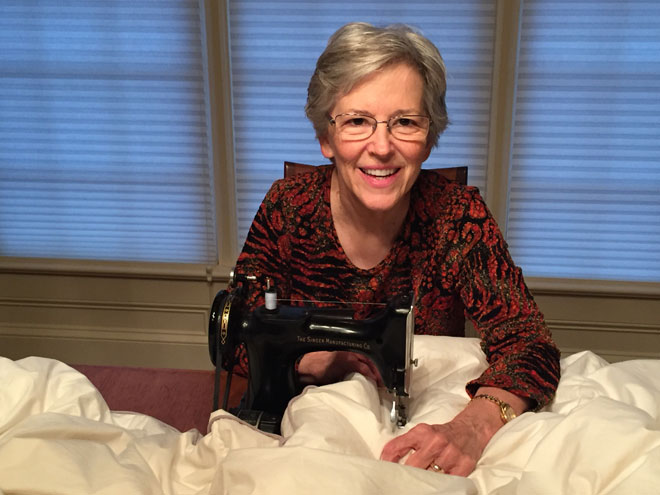In the winter of 2015, members of Historic Deerfield’s Curatorial Department discovered evidence of an infestation in two of the museum’s historic houses. Routine inspection of both the Sheldon and Williams houses revealed the presence of insects that are harmful to collection objects. Case making clothes moth larvae ( Tinea pellionella) were found on some woolen textiles in both houses. While the discovery of the infestation was disturbing, the action taken and lessons learned provided curatorial staff with a more responsive and proactive strategy for the future.
Piles of granular frass, or insect feces, matching the color of the textiles on which they were found, was our immediate indication that we had an active infestation. To start, we removed all of the textiles from the affected rooms. While case making/clothes webbing moths are most attracted to textiles made from protein fibers like wool blankets and pillows stuffed with down, we also pulled other items (such as linen bed sheets and pillow cases) for evaluation. On the advice of conservators, those textiles that were affected by or in close proximity to the insects were frozen in a specially purchased chest freezer. The recommended procedure was to freeze the textiles at -20 degrees F for 72 hours, thaw to room temperature, and then freeze a second time. This cycle guaranteed the destruction of any remaining insects or larvae. Upon their removal from the freezer and acclimation to room temperature, the textiles were carefully inspected, and then vacuumed using low suction through a fiberglass screen, both of which prevent actual textile threads from being accidentally sucked into the nozzle.
At the same time, Curatorial and Housekeeping staff cleaned and vacuumed the historic house interiors, paying special attention to crevices in furniture joins and floor boards where eggs and larvae could hide undetected. One item of particular concern was an adult cradle in the Sheldon House that housed a particularly badly infested wool blanket. There was concern about the possibility larvae or eggs could have fallen into the joints of the furniture, providing a relatively protected area for them to hatch. To prevent that scenario, we sent the cradle to the Williamstown Art Conservation Center (WACC) in Williamstown, Massachusetts. There, it was placed in an oxygen-deprived (anoxic) chamber for several weeks to mitigate any lingering insects.
The next step was for the Curatorial Department to review current installation conditions in all the historic houses. With the support of the museum’s Collections Committee, an advisory group of our museum trustees and outside consultants, the department instituted some very positive changes.
We addressed the foundations of our dressed bedsteads, staples in our house interpretations. We removed and disposed of old mattresses (known as bed ticks) and pillows, that were filled with horsehair or down (more protein substances that provide a tempting treat for insects). To replace them, volunteer Jean Ritok (see below) and Collections Manager and Associate Curator of Textiles Ned Lazaro created modern reproductions. Lazaro washed cotton fabric (to remove chemical sizing) and created a pattern or template for new bed ticks based on the originals. These reproductions were stuffed with inert, polyester fiber-fil. These new mattresses and pillows are not only lighter in weight, but can more easily approximate the ideal “look” of a properly stuffed bed tick from the 18th and early 19th centuries, while removing the added risk of infestation when displaying, say, a wool whole cloth quilt. Together with Bartels Curatorial Intern Paithan Campbell, Lazaro installed these into the Sheldon House, the historic house hardest hit by the infestation. Now as a prototype, the Sheldon House’s four beds are now dressed with these new and improved bed ticks.
Pheromone traps were installed in the houses. These traps lure and capture insects that are typically drawn to protein fibers through the use of pheromones, or chemicals used to attract them. Routine checking of these traps has thankfully not revealed a recurrence of the case making clothes moths’ presence.
Before the museum re-opened to the public, Ned Lazaro and Amanda Lange introduced some new preventative conservation procedures for the historic houses. New practices that the museum staff agreed upon included closing all entrances to the historic houses as much as possible. Previously guiding staff would occasionally keep the front doors open in warmer weather to allow fresh air into the house. However, these open doors allowed insects and small animals to penetrate into the house interior, and introduced air born particulates (such as moisture-laden microscopic dust particles) into the house environments at a faster rate.
Our future goals include the replacement of all the down- or horsehair-filled bed ticks and pillows that are currently used in the houses with polyester-filled reproductions. While we still have far to go making sure all of our preventative conservation practices are in effect throughout the museum, thanks to the IMLS Conservation Survey we were more prepared for this problem than we had been in the past and had access to some of the best minds in preventative conservation.
